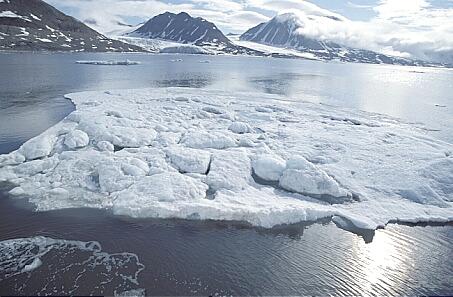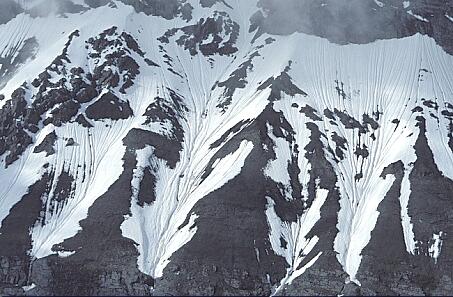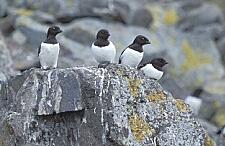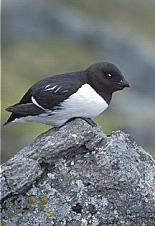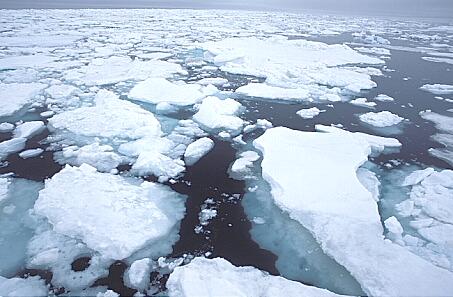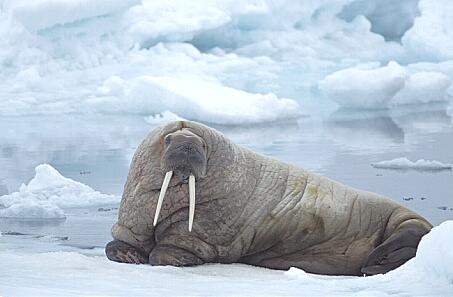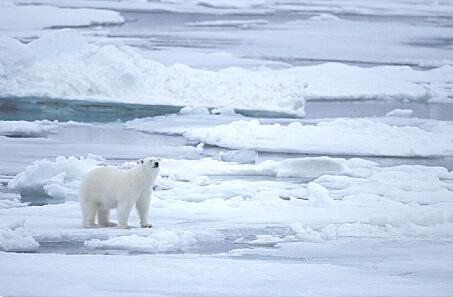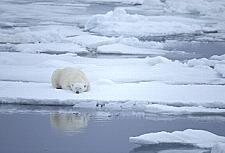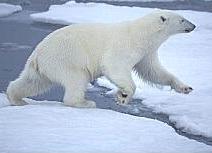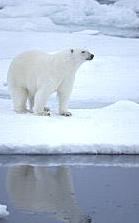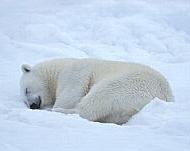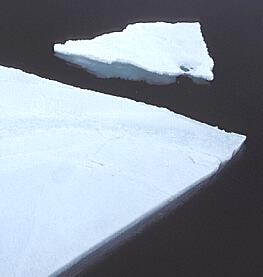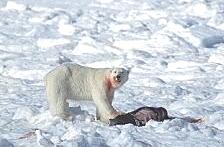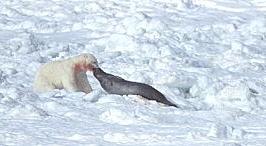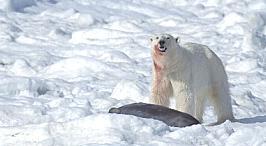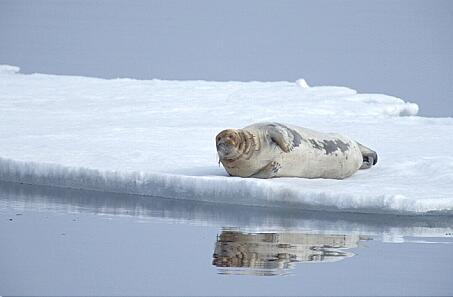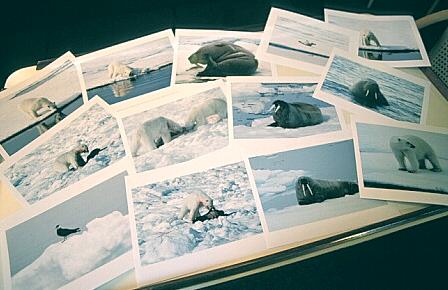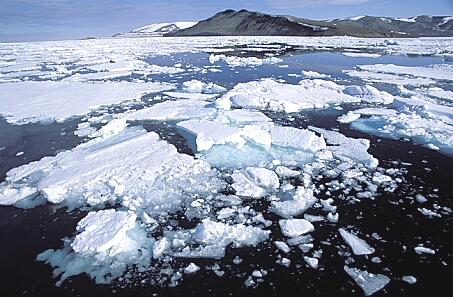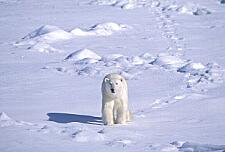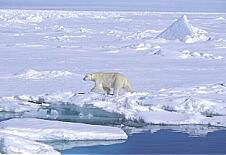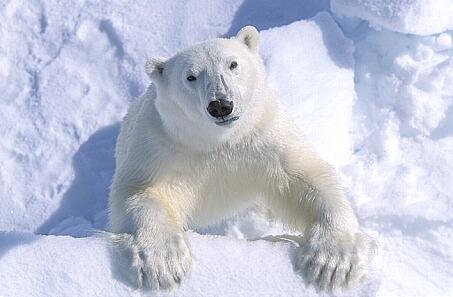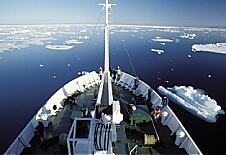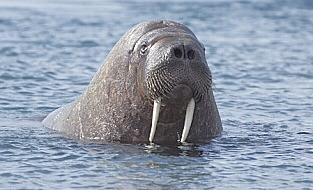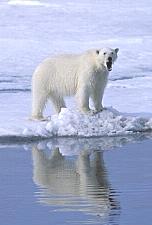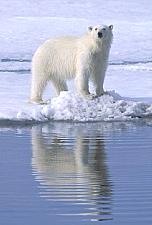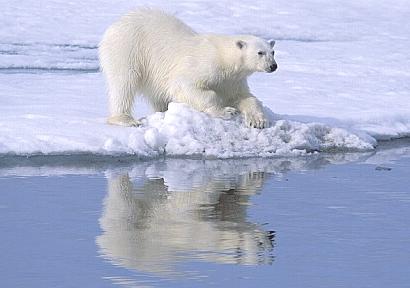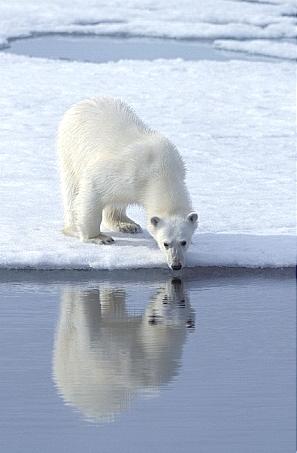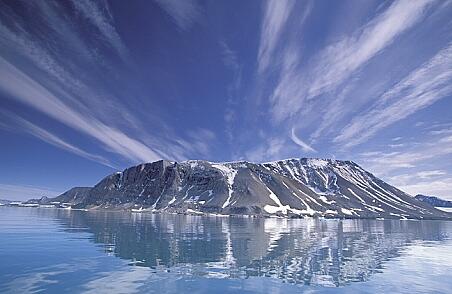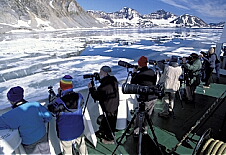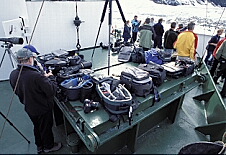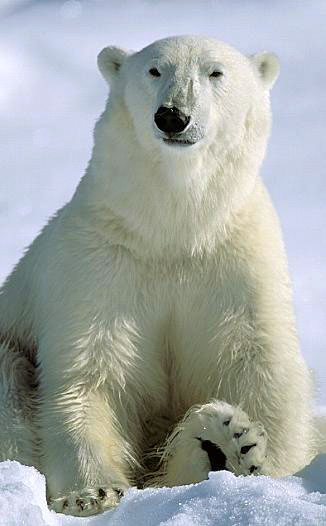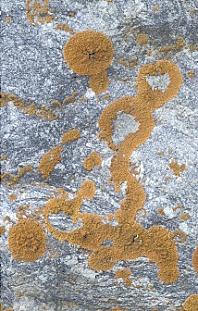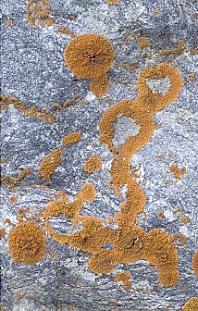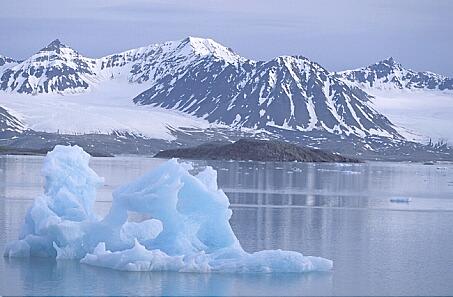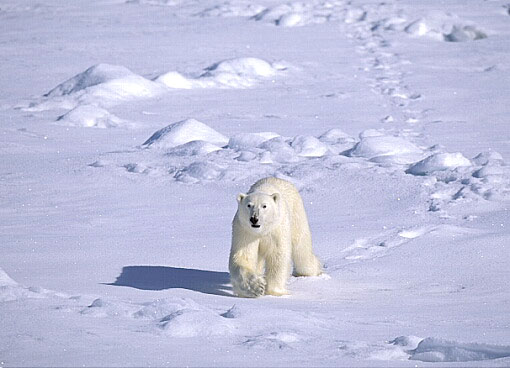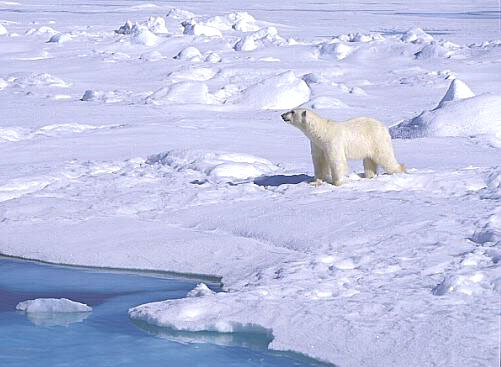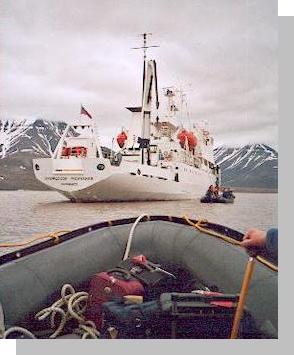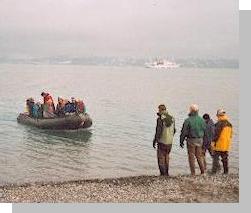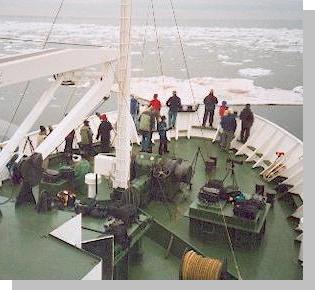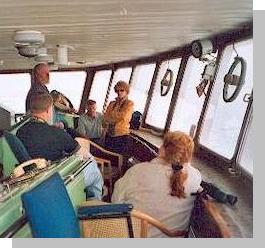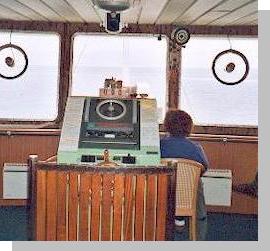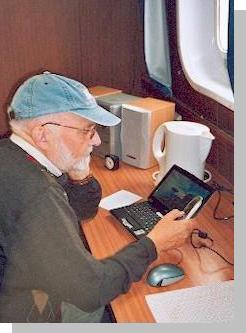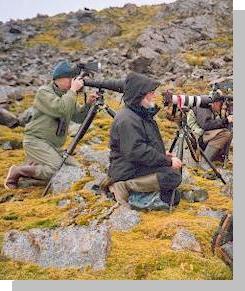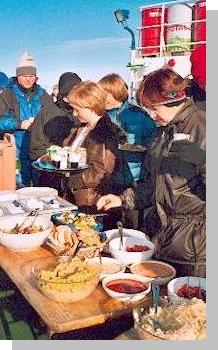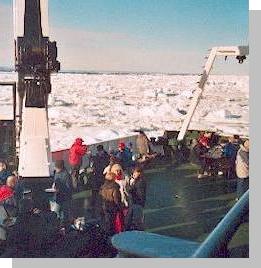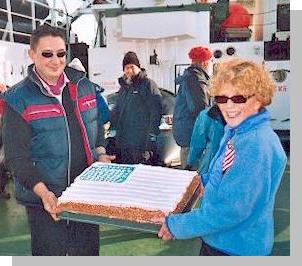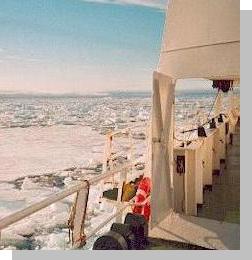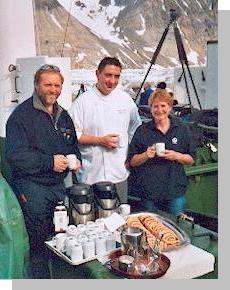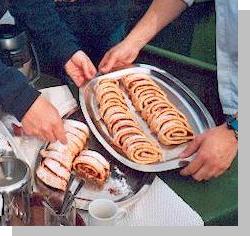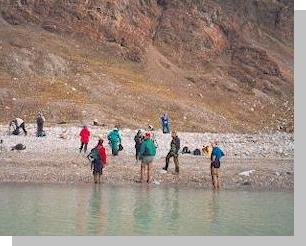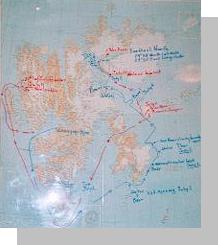|
Fritz Pölking Hunting the
polar bears in summer Joseph Van Os Photo Safaris Ltd. (www.photosafaris.com) advertised a two-week tour of Svalbard (Spitzbergen) by ship and the offer was so tempting that I just couldn’t resist. My lenses for this trip had focal lengths of 3.5-4.5/20 -35mm, 3.5-4.5/28 -105mm, 2.8/80 -200mm, 4.0/500mm and with these, the two 1.4 x and 2x converters. In addition to that, two camera
bodys (EOS-1V and as a back-up the EOS-3 ), a Gitzo Carbon tripod Nr. 1227 with
a Kirk Ball Head In the past I would have taken at least 200-250 rolls of film in order to provide all agencies with original slides but instead of sending out the original slides I supply them today with CD-ROMs that contain the files with my best pictures. This means that I actually only need a fourth of the amount of rolls from before. Day 1 On the first day of the program the flight took across the big pond to Oslo. Day 2 Starting out from Germany, it was sufficient to leave in the afternoon of the second day from Frankfurt. The flight to Oslo took about 2 hours and we were there in time for the first meeting of the group, for dinner at 7pm followed by a briefing. Day 3 On the third day we started out in Oslo with the flight to Svalbard (Spitzbergen) at about 9am, which had a short lay-over in Tromsö. We reached the Longvearbyen airport on Spitzbergen at about 2pm and by 4pm 48 nature photographers were already gathered on the Russian ship "Professor Molchanov", a ship that was used for research and then rebuilt. We were waiting there expectantly as to what would happen next. Day 4 Fog until 9am, then sunshine, blue skies and scattered but photogenic clouds…. and… at 10am already the first polar bear. Unfortunately too far away for the telephoto lenses. In any case, it was already obvious that the landscape surrounding the polar bears was basically much more attractive in comparison to Churchill, "the world capitol of the polar bear" and where you have an almost impossible task imposed to keep the tire tracks of the tundra buggies out of your pictures. We had our first shore outing that afternoon and went to the Little Auk which filled out a picture format with 500 and 700 mm. It was a huge colony along a rocky mountainside with at least 50.000 specimens.
Day 5 The sea meant us no harm and we had what mariners call a "still pond". At about 9.30 we reached bear country, a part of Spitzbergen where a lot of the 2.000 polar bears located there enjoy being, among the chunks of ice and snow and which is located not far from the area where the female bears build their snow caves in order to bring their young into this world. The morning brought us pretty fields of ice and 3 lone walruses floating on chunks of ice. The afternoon brought us another walrus on another floating chunk of ice, a polar bear swimming in the water and rain. Joe Van Os took advantage of the late afternoon rain to give us a slide show on correct exposure times of motifs that are lighter than the middle grayscale. Then, after dinner, a friendly polar bear appeared on the islands of ice and allowed photographers to take pictures of him for over an hour and a half from the ship where the light meter, using an exposure setting of 4.0, showed 1/320 sec with an ISO 100 film at 10.10 pm. That is the advantage of being so close to the North Pole (600 miles away from it) where you don’t have any darkness for 24 hours during a day.
Day 6 The next morning presented us with a sea as smooth as glass and the wonderful reflection of the drifting fields of ice which looked very pretty in the wide angle zoom with polarization filter. Four times bearded seals allowed us to take pictures of them on moving ice fields, some even with their reflection in the water. The afternoon brought THE wildlife action high-light of the entire trip: a polar bear was pulling a bearded seal he had just slain out of the water and dragged it about 20 meters across the ice, leaving a bloody trail. Then he started to feed and the surrounding snow was soon bloody just as the polar bear’s head and neck was turning red from seal’s blood. This produced real life pictures which will certainly not be very successful. Most of the magazine producers do not want to publish this amount of reality. Then as a climax another polar bear arrived an hour later and the first one allowed him to feed from the seal with him for about 15 minutes before he chased him away. The first polar bear then proceeded to feed for the next (believe it or not) six hours from the seal at a fitting distance for a 500mm lens without converter. So there was more then enough time for everyone to take as many bloody pictures about the reality of life as the heart desired. This is the main fun factor of digital photography: You take sensational pictures of a polar bear with his seal and look at them a hour later at the ship’s bar on a lap top, print them out and share your results with everyone on board. Taking these pictures on
celluloid will take weeks before you know what you photographed, how you
caught it and if the technical and creative quality is ok.
Hours later in the ship's
bar the digital user can share Day 7 The morning presented us with a magical landscape at 2° above freezing and snow-covered mountains as background and a completely calm sea with drifting ice blocks and mirrored mountains, blocks and fields of ice. At about 9 pm an about 6 year old polar bear came to share our company for about 2 hours. Format filling beginning at 400 mm focal length. He was in mint condition judging by his fur and coloring. It seemed almost as if he just came out of a game farm where he was styled for a film production. Those who frequently photograph Churchill polar bears will be thrilled about this fantastic setting the polar bears move around in. After lunch John Shaw held a slide show on nature photography. The afternoon presented us with an almost normal array of attractive fields of ice and a resting walrus as well as several bears, among them a female with 2 cubs. Unfortunately though not close enough to take pictures of.
Day 8 Following a dance and b-b-q last night on deck, celebrating Independence Day on the 4th of July, no-one was much in a mood to take pictures today. Nevertheless the Zodiac rubber boats took us to a large colony of walruses in order take pictures of them ashore. After the first two boats, the trip was cancelled due to rain thank God, and we went to a large bird colony instead, postponing the walruses to the following day. The three hours it took by ship to get to the birds was filled by Dr. Wayne Lynch with a slide show about polar bears. Unfortunately a closed icecap did not allow us to approach the bird colony and we returned over night to the walruses, not missing out on filling the hours between 9pm and midnight with magical landscape pictures.
Day 9 This morning it was walrus time. About 40 walruses were dozing on the beach as we approached them with the zodiacs and went on shore. We made ourselves comfortable at about 100 meters in distance and close to the water. Shortly thereafter 5-10 walruses went into the water and swam to us, only keeping a distance of a few meters. Apparently they had seen few if no humans and wanted to come and inspect us. For about 2 hours we took pictures of them with their incredible tusks every time they surfaced in front of us. On the way to the afternoon shoot of the polar bears on ice, Rinie Van Meurs held a slide show about Greenland.
Day 10 The ship was embedded in fields of ice until breakfast. Then we started our search for polar bears again, if possible with a slain seal. Towards 10am we did find one and were able to take pictures for 2 hours, in part with wonderful reflections off the water, in a high format which was filled at 500mm and with brilliant sunshine. During the afternoon on our way to the Nordic flower fields, Dr. Wayne Lynch held a slide show about the world of birds in the Arctica.
Day 11 This morning there was a slide show about walruses given by Rinie Van Meurs and following that, one about Iceland from Tom Harrison and one about Spain from Joe Van Os. There was a good opportunity to take flight pictures when the ship was moving, especially of northern fulmars and three toed seagulls which love to sail past the ship at close range and provided us with fantastic motifs. In the afternoon we reached a bay with a glacier as background to the fields of ice. The surrounding mountains were reflected superbly in the water and everyone took pictures of ice bergs, floating ice bergs, reflections, mountains with reflections and similar things so that the polar bear who was on the floating ice bergs was actually hardly noticed at all.
Day 12 Today we reached the bay with the fields of flowers and close by rocks covered with lichen that provided us with many pretty motifs.
This was a good opportunity to try out the new Velvia – 100 film material. During the nature photography festival in Fürstenfeldbruck Fuji passed out the first samples and I was able to get five rolls. The first try three weeks ago in Rwanda with the gorillas wasn’t so great. The Velvia – 100 seems to be harsher in the gradation in comparison to the Sensia – 100 and it certainly is not the kind of film to use when taking pictures of gorillas in the sun. Let’s see how the pictures with this film turn out here with cast-over skies in comparison to the Sensia – 100. Later we took a picture of the glacier "14. July" with the beautiful last light.
Sensia -100 Velvia -100 Day 13 After a sudden change of weather the sea was so rough, the wind so harsh, the temperatures so low and the sight so bad that this trip was postponed and we waited with the anchor down in hopes that the conditions would get better in the afternoon. In the meantime Dr. Wayne Lynch talked about close – up photography. But the weather did not improve and our last day of photography was lost. Kismet…. 34 nature photographers on board were working with analog SLR cameras (22 Nikon and 12 Canon), 8 worked with digital cameras by Nikon or Canon. Five of them had their laptop on board and one even had a printer with him. 3 lady participants had small digital film cameras. As far as lenses were concerned, there was a 4.0/600mm, about 20 4.0/500 mm and another 20 had the relatively new 80/100-400 mm zoom lenses.
Day 14 We arrived in Longyearbyen in the morning and took a stroll through the "city" before we left Spitzbergen in order to fly to Oslo with an expected time of arrival at about 8pm. Since most of the big birds returning to Europe have already left by then we needed to spend the night. Day 15 The plane that leaves early in the morning at 6.35 am from Oslo to Frankfurt had been booked out for some time which meant we had to take the one at 12.50 pm with an expected time of arrival at 3 pm in Frankfurt. The connection flight to Münster / Osnabrück was at 4.45 pm with an time of arrival in Münster/Osnabrück at 5.45 pm. And we were back home at 6.15 pm. One of the advantages of living close to the airport.
Photographic notes of a ship journey Photos: Gisela Pölking
If anyone is interested in the Svalbard (Spitzbergen) adventure: * * * * * *
|

